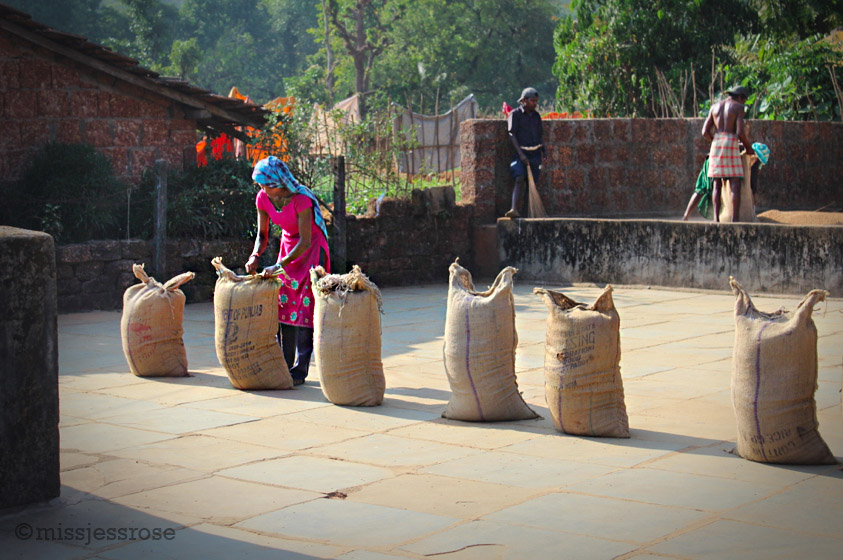Goa is where we motorbike through dry rural winding country backroads, weaving past gypsy camps filled with colorful Rajasthani women who wear brilliant red orange saris and layers of silver jewelry. Tents line the road where these workers from the north live temporarily doing hard construction labor, carrying bowls of rock on their head. Yaks and cows lazily wander, oblivious to the cars and motorbikes that zip past. The farther away from the beach we get, the more worn and dry the landscape becomes. Yellow haystacks á la Monet and brown rice paddies void of crop or water fly past as we move deeper inland.
We are searching for Savari waterfalls in the Netravali Wildlife Sanctuary, some place we heard rumor of from a friendly Swede on the beach. Netravali is part of a vast undeveloped nature preserve in a mountain range known as the Western Ghats, which is apparently one of the most biodiverse regions in the world. But here, as in all of India, there are no marked directional signs or addresses, nor is there information telling us that these jungles contain some 300 globally endangered species. We are left to explore on our own, and we don't find out that this is such a rich region full of exotic animals and plants until later.
Besides rice, the region produces large red bricks such as these. We pass several quarries on our ride.
Along the way we stop at the famous Netravali Bubble Lake, or Budbudyanchi Tali adjacent to Gopinath temple right smack in the middle of nowhere. Visitors come to peer at the lake and its mysterious bubbles, a curious phenomenon believed to be caused by a local deity. In the otherwise silent forest I feel quite silly clapping my hands loudly, trying get the pool in front of me to "perform." Small lines of bubbles begin to emerge from the clear water, but what burps forth is all a bit anti-climactic compared to what I'd imagined when I first read about the wonder.
The Netravali Bubble Lake, or Budbudyanchi Tali
As we climb higher and higher in altitude, we pass a granary with piles of rice laid on the cement to sun dry. Men and women are hard at work sweeping and bagging the crop. I feel so bumbling and foreign taking photos of all these unfamiliar sights, of the workers. I suspect they think I'm crazy, snapping away while they labor. The uncomfortable feeling that I'm intruding on their lives creeps up on me, but it's long familiar territory that comes with being a photographer and I tuck it away.
Now at a higher altitude, the landscape has changed. Monkeys cross our path swinging from branches in the lush green rainforest. A small Hindu temple shrine with burning incense and tinkling bells sits along the roadside. The higher we climb, the more narrow and bumpy the road becomes.
At last we come to the end of a dirt road. Up here it is moist. Glistening rice paddies and palm trees sprawl before us, opposite from the dried fields down below. Thanks to the guidance of a local man, we begin hiking along an irrigation ditch towards the waterfalls. It feels like we're passing through people's private property, but the man tells us the land is leased by the farmers who cultivate rice crop. It seems to be okay for us to be here. Cows and yaks rest in their wooden lean-tos. Nuts are spread out to dry on a roof. Old ladies squat and scrub laundry in the stream.
The hiking trail weaves past private homes such as this one
Washing laundry in the irrigation stream
We hike for just less than an hour before we reach the falls. The water is cool and crisp. Even this far into the remote jungle there are plenty of piles of garbage strewn carelessly about. Bright red soda cans and piles of shiny plastic distract from the natural beauty of this little paradise. My Western mind wants to pick up every piece of junk and return it to a proper garbage heap, only I know that in India there is no such thing. So instead I rest and listen to the peaceful falling water.
Hiking alongside an irrigation ditch that leads from the waterfall to the rice paddies
Hiking back out past the rice paddies
It's not until we're back at the beach after our waterfall excursion that I discover the jungle hike we went on is famous for leopards.
I'm still not sure if I'm more relieved or disturbed that I didn't know sooner.


















